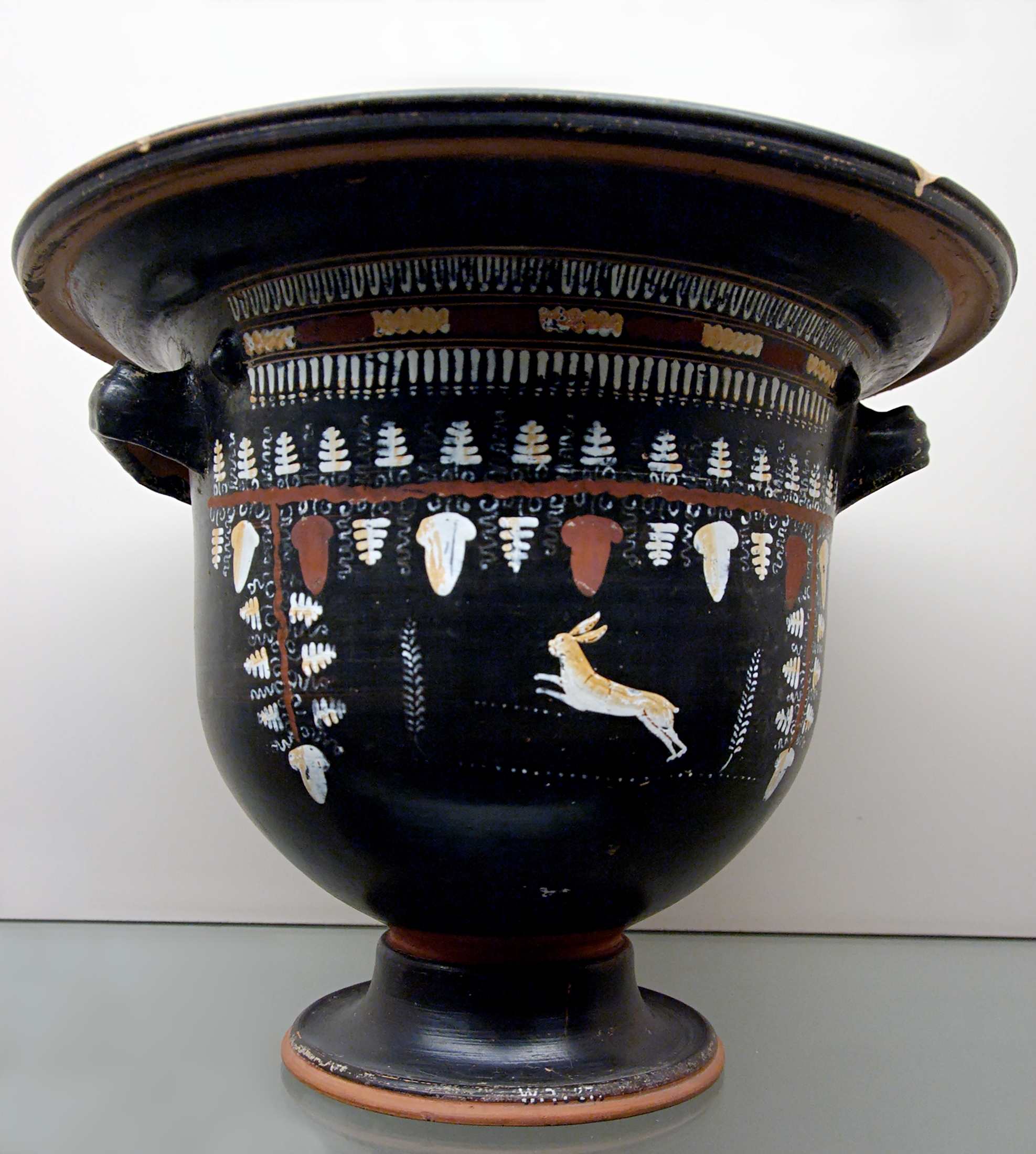|
West Slope Ware
The modern term West Slope pottery describes a type of Greek fine pottery from the Late Classical and Hellenistic periods. West Slope pottery was especially widespread in the Eastern Mediterranean region. The name was coined in 1901 by Carl Watzinger, based on finds from the western slope of the Acropolis at Athens. West Slope pottery is a subtype of Black-glazed Ware. It was additionally decorated with white, yellow and pink clay slip, incisions, vertical ribbing and imprinted roulette decoration. The type developed during the 4th century BC out of a pottery style with applied yellowish-orange plastic ornaments that imitated gilding. West Slope pottery is especially well known from Athens, but several other production centres have been identified. Especially Pergamon is noteworthy in this regard. Since Athens had lost its dominant role in the Mediterranean pottery markets by this time, it should not be assumed that the form is a particularly Attic one, but rather that Athen ... [...More Info...] [...Related Items...] OR: [Wikipedia] [Google] [Baidu] |
3277 - Athens - Stoà Of Attalus Museum - Kantharoi - Photo By Giovanni Dall'Orto, Nov 9 2009
3 (three) is a number, numeral and digit. It is the natural number following 2 and preceding 4, and is the smallest odd prime number and the only prime preceding a square number. It has religious or cultural significance in many societies. Evolution of the Arabic digit The use of three lines to denote the number 3 occurred in many writing systems, including some (like Roman and Chinese numerals) that are still in use. That was also the original representation of 3 in the Brahmic (Indian) numerical notation, its earliest forms aligned vertically. However, during the Gupta Empire the sign was modified by the addition of a curve on each line. The Nāgarī script rotated the lines clockwise, so they appeared horizontally, and ended each line with a short downward stroke on the right. In cursive script, the three strokes were eventually connected to form a glyph resembling a with an additional stroke at the bottom: ३. The Indian digits spread to the Caliphate in the 9th ... [...More Info...] [...Related Items...] OR: [Wikipedia] [Google] [Baidu] |
Krater
A krater or crater ( grc-gre, , ''kratēr'', literally "mixing vessel") was a large two-handled shape of vase in Ancient Greek pottery and metalwork, mostly used for the mixing of wine with water. Form and function At a Greek symposium, kraters were placed in the center of the room. They were quite large, so they were not easily portable when filled. Thus, the wine-water mixture would be withdrawn from the krater with other vessels, such as a ''kyathos'' (pl. ''kyathoi''), an ''amphora'' (pl. ''amphorai''), or a ''kylix'' (pl. ''kylikes''). In fact, Homer's ''Odyssey'' describes a steward drawing wine from a krater at a banquet and then running to and fro pouring the wine into guests' drinking cups. The modern Greek word now used for undiluted wine, ''krasi'' ( κρασί), originates from the ''krasis'' (''κράσις'', i.e., mixing) of wine and water in kraters. Pottery kraters were glazed on the interior to make the surface of the clay more impervious for holding wate ... [...More Info...] [...Related Items...] OR: [Wikipedia] [Google] [Baidu] |
Gnathia Vases
Gnathia vases are a type of pottery belonging to ancient Apulian vase painting of the 4th century BC. They are named after the ancient city of Gnatia, Gnathia (now Egnazia) in Eastern Apulia. There, the first examples of the style were discovered in the mid-19th century. Their production began in Apulia around 370/360 BC, in parallel to the local version of the red-figure vase painting, red-figure style which developed tendencies towards polychromy around that time. Typical of Gnathia vases is the application of different paints directly onto the glazed vase body. Additionally, internal details could be added by incision. The themes depicted include eros, erotes, images from the life of women, theatre scenes and Dionysos, dionysiac motifs. Figural, painting is often limited to the upper half of the vessel body, while the bottom half often bears only ornamental decoration. The most common shapes were bell kraters, ''pelikes'', ''oinochoe, oinochoai'' and ''skyphos, skyphoi''. The mos ... [...More Info...] [...Related Items...] OR: [Wikipedia] [Google] [Baidu] |
West Mediterranean
The Mediterranean Sea is a sea connected to the Atlantic Ocean, surrounded by the Mediterranean Basin and almost completely enclosed by land: on the north by Western and Southern Europe and Anatolia, on the south by North Africa, and on the east by the Levant. The Sea has played a central role in the history of Western civilization. Geological evidence indicates that around 5.9 million years ago, the Mediterranean was cut off from the Atlantic and was partly or completely desiccated over a period of some 600,000 years during the Messinian salinity crisis before being refilled by the Zanclean flood about 5.3 million years ago. The Mediterranean Sea covers an area of about , representing 0.7% of the global ocean surface, but its connection to the Atlantic via the Strait of Gibraltar—the narrow strait that connects the Atlantic Ocean to the Mediterranean Sea and separates the Iberian Peninsula in Europe from Morocco in Africa—is only wide. The Mediterranean Sea enc ... [...More Info...] [...Related Items...] OR: [Wikipedia] [Google] [Baidu] |


